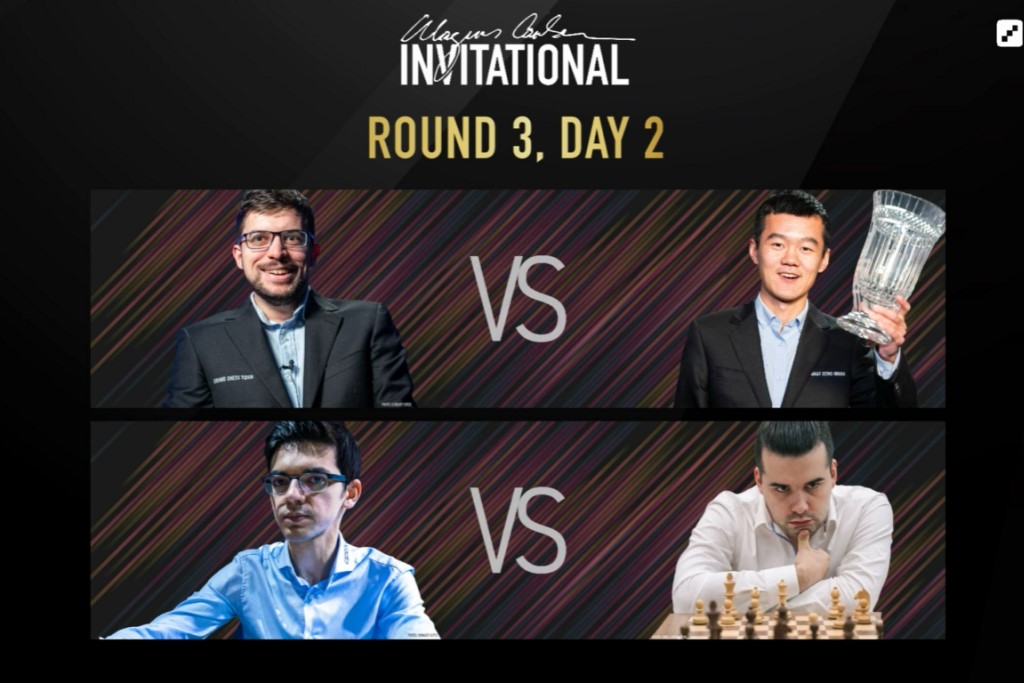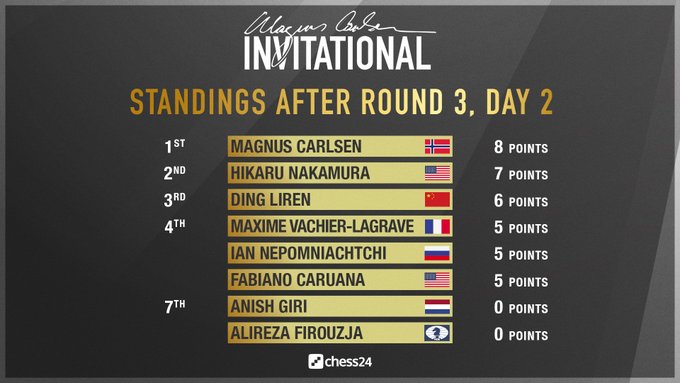


The sixth day of action at the Magnus Carlsen Invitational saw seven out of eight rapid games finishing drawn. Ian Nepomniachtchi beat Anish Giri with the white pieces in game two, which was enough to get match victory given the points were split in the remaining encounters. Meanwhile, Ding Liren and Maxime Vachier-Lagrave drew all four of their 15'+10" games and went to Armageddon.
Vachier-Lagrave won the "digital toss" and chose to play black, getting a one-minute edge on the clock but knowing that a draw would be enough to win the match. The big shock came seconds into the start of the game, as after 1.d4 d5 2.c4 c6 3.Nf3 Nf6 4.Nc3 the French grandmaster played 4...Bf5, a move almost never seen at the GM-level. Apparently, he had some lines studied and wanted to surprise his opponent — or, as the commentators speculated, he might have pre-moved it. Nevertheless, Ding was ruthless in showing the weakness of that manoeuvre and won the game in merely 16 moves.
After three rounds, Carlsen is in the sole lead, with Giri and Alireza Firouzja yet to score a match point — the Dutchman has not won a single game. The top four in the standings after seven rounds advance to the knockout semi-finals:

All four rapid games of this match-up lasted over forty moves, and all of them were tensely contested fights in which no big blunders tipped the balance. Ding played 1.d4 both times he got white, and once again — as in the two previous rounds — Vachier-Lagrave did not go for his pet Grünfeld, experimenting with the Slav instead. Both times the queens left the board in the middlegame, and Ding could not make the most of his slight positional pluses. A similar story developed when Vachier-Lagrave was white.
The key moment of the match was the sudden-death decider. Ding got white and an endlessly repeated series of moves kicked off the game — 1.d4 d5 2.c4 c6 3.Nf3 Nf6 4.Nc3:
At this stage of the game, club players and grandmasters alike are still well within theory, but when 'MVL' went for 4...Bf5 the commentators were already shocked, wondering whether the Frenchman kept an ace up his sleeve or if he had simply blundered. This was the position six moves later:
Black wants to give a check from c2, but it is his king the one in deeper trouble. The game continued 11.Qa4+ Kd8 12.Bd2 (creating the threat of Ba5 if the knight moves) Nc2+ 13.Ke2 Qxb2 and after the white knight joins the attack with 14.Ne5 Black is busted. Vachier-Lagrave resigned two moves later.
'MVL' has collected 5 points so far, so he is still very much in the fight to reach the semi-finals. The Frenchman will have a chance to bounce back from this strange loss on Friday (no rest day for him this time) when he faces none other than Magnus Carlsen. Let us not forget that he defeated the world champion in the semi-finals of last year's London Chess Classic.
Select an entry from the list to switch between games
Giri is having a tough time in the Invitational, as he has lost all three matches without even reaching the tiebreaker. Nepomniachtchi, on the other hand, showed good chess throughout, but has been having trouble converting his advantages at times.
Game one was a rather quiet draw, and the one decisive result of the match came immediately afterwards. 'Nepo' gave up an exchange for two pawns and the initiative. Giri was defending well, but things got trickier for him once the queens left the board and White's passed a-pawn started to move forward:
Black faltered with 59...Rg1, as White can ignore the threat against his g-pawn and start advancing on the queenside — 60.a5. Nepomniachtchi showed good technique and scored a 77-move win.
Giri got a clearly superior position the very next game, but had trouble handling a mating threat and ended up giving up his advantage:
In order to prevent Black's threat of mate on h1, Giri went for 35.Rb1, giving Black a couple of tempi to deal with the dangerous passer on the h-file — 35...Rc8 36.Re1 Rh8. Instead, White could have played 35.f3, giving up a pawn while keeping his threats alive. After the text, Nepomniachtchi managed to stabilize the position and a draw was eventually agreed.
Giri needed to win on demand in game four. He did get a slight edge with black, but 'Nepo' managed to keep things under control and secure match victory. The Russian later explained why winning without tiebreaks (thus getting an extra point) is particularly important in this event:
We have two players [Firouzja and Giri] with a little bit less points than they deserve, so this means we have a lot of players with extra points. So that's [why] it makes a difference [...] This is obvious, but, especially because of the current system, it is very important, more than usual.
Select an entry from the list to switch between games
IM Lawrence Trent analysed the action of the day
The Magnus Carlsen Invitational is brought to you by chess24.com. Learn more about the tournament at magnuscarlsen.com/en/invitational